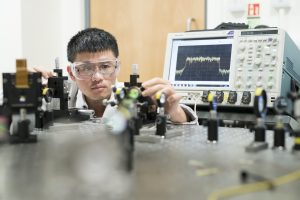The Photonics team’s research has focussed largely on the areas of microwave photonics and convergence between optical fibre and wireless communications technologies, exploiting synergies with other teams in the Communications research group. It has also comprised research into optical waveguide structures on glass substrates, suitable for integration technology and has recently expanded to incorporate new interdisciplinary activity for industrial, biomedical and defence applications. The team collaborates with UK industry and academia, and internationally through a number of EU grants, including membership on the management committee of an EU COST network on Integrated Microwave Photonics. Strong industry links with ADVA Optical Networking, VIAVI, BT, Orange, Hitachi and others underpin our research.

In the microwave photonics for fibre communications area, the team is internationally recognised having demonstrated the first optical millimeter-wave generation in a single semiconductor laser device, and the widest then-reported locking bandwidths in optically injection-locked oscillators; it led the radio over fibre research in the FUTON EU Integrated Project which first developed many Cloud-Radio Access Network (C-RAN) concepts, the delivery of stable millimetre-wave optical reference signals over long fibre links in the international ALMA radio astronomy project, and coordinated the EU and UK projects iCIRRUS and NIRVANA which pioneered a new Ethernet fronthaul for 5G mobile networks.
High-speed photonic signal processing and imaging techniques have been developed to achieve real-time high-throughput detection for applications in data communication, biological screening and machine vision. In many of these applications, signals and phenomena of interest tend to be random with low probability and occur on time scales that are too fast to be sampled and digitized in real time, and at throughputs that challenge the state-of-the-art data storage and processing technologies. Novel photonic techniques are being developed for real-time instruments that are able to capture fast non-repetitive events in real-time, and at the same time, to manage the vast volume of data produced by such instruments. Several projects in high-speed photonic signal processing and imaging are on-going at Kent.
